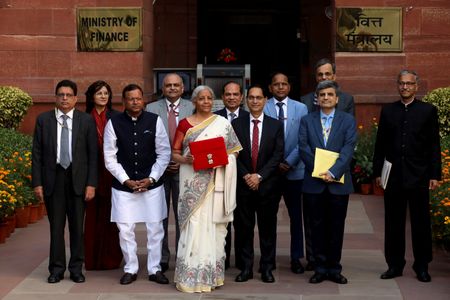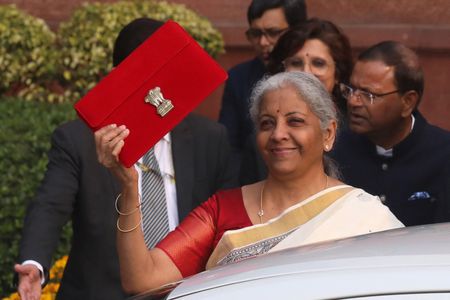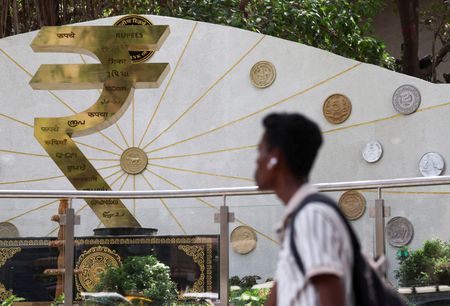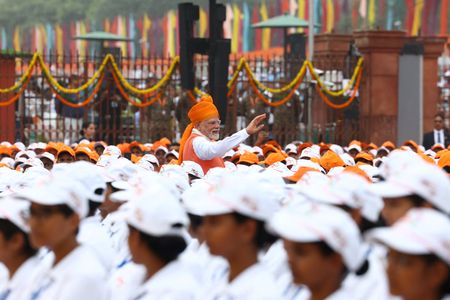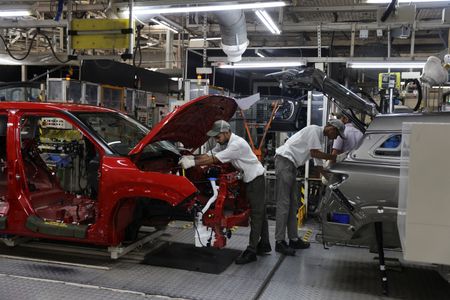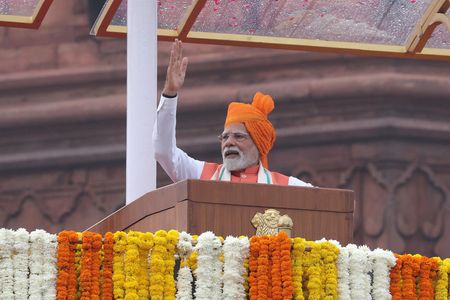By Nikunj Ohri, Shivangi Acharya and Sarita Chaganti Singh
NEW DELHI (Reuters) -India slashed personal tax rates in its annual budget on Saturday, as the world’s fifth largest economy focuses on boosting domestic demand amid uncertainty over the global economic outlook due to potential new tariff barriers.
The world’s most populous country is expected to post its slowest growth in four years next year amid frail urban demand and weak private investment, while stubbornly high food inflation has dented disposable incomes.
The government said people earning up to 1.28 million Indian rupees ($14,800) per year will not have to pay any taxes, raising its threshold from 700,000 rupees. It also lowered tax rates for people earning above the new threshold.
“The new structure will reduce taxes on middle class and leave more money in their hands, boosting household consumption, savings and investment,” Finance Minister Nirmala Sitharaman said in parliament.
The move will result in an annual 1 trillion Indian rupee ($11.6 billion) hit to Treasury revenues.
Measures to assist the poor, youth, farmers and women were also included in the budget for 2025-26, Sitharaman said.
Increasing living costs have weighed on the popularity of Prime Minister Narendra Modi, with one survey showing more Indians are becoming less hopeful about their quality of life.
Per capital income is around $2,700 for India’s population of 1.4 billion, with about one-third considered middle class.
The tax cut is “likely to spur consumer demand and savings by the middle class that has faced challenges from elevated inflation and lower income growth,” Sakshi Gupta, economist at HDFC Bank.
The move led to a rally in consumer stocks such as Maruti Suzuki, Godrej Consumer Products and Prestige Estates, which jumped by 4% to 8%.
To balance the revenue lost, the government has budgeted for a modest increase in capital spending this year, which will rise to 11.21 trillion rupees in 2025-26 compared to a lowered 10.18 trillion in the current year.
The modest infrastructure spending increase disappointed investors in the sector and stocks of firms including Larsen & Toubro, NBCC, IRB Infra and KEC International < KECL.NS> were down between 1% and 6%.
The government expects to improve its finances, targeting a fiscal deficit of 4.4% of GDP in 2025-26, down from a revised 4.8% of GDP in the current year.
It will borrow 14.82 trillion Indian rupees via the bond markets to fund this year’s fiscal deficit.
The government, however, refrained from pre-empting the impact of potential tariffs from U.S. President Donald Trump on India and focussed on lowering some input costs for industries that have been raising output such as electronics and
renewables.
FOCUS ON FARM, MANUFACTURING AND FINANCIAL SECTOR
India has faced a bout of high food inflation over the past year due to weather changes impacting output.
To boost productivity across the farm sector, the government will launch a national mission to push high-yielding crops, with a special focus on pulses and cotton production.
To help farmers, the limit for subsidised credit has been raised to 500,000 Indian rupees ($5,778) from 300,000 rupees earlier.
The government will also launch missions to push manufacturing and exports, Sitharaman said, without going into details.
India has long aimed to boost the share of manufacturing and exports in its economy but has had little success. The share of manufacturing in the economy has remained close to 17%, short of its long-standing goal of 25%.
To deepen the penetration of insurance in the economy, the foreign direct investment limit on insurance was raised to 100% from 74% currently.
($1 = 86.5360 Indian rupees)
(Reporting by Shivangi Acharya and Nikunj Ohri in New Delhi; Writing by Ira Dugal and Aftab Ahmed; Editing by Lincoln Feast)

